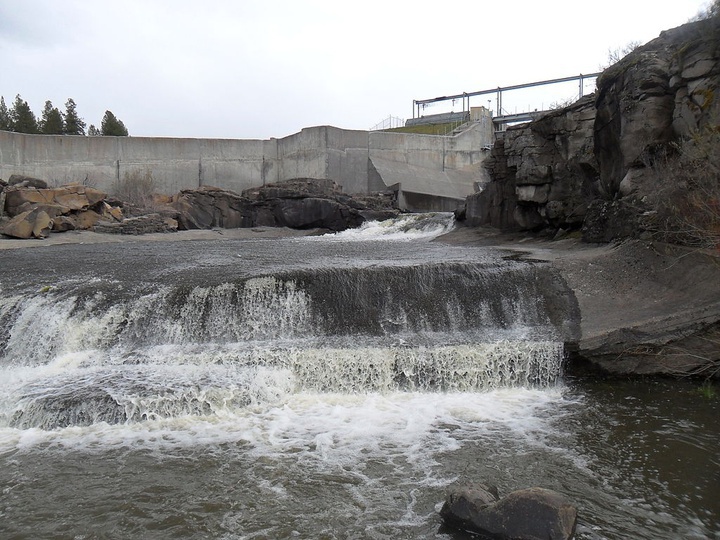Jessica Cejnar / Friday, July 16, 2021 @ 3:28 p.m. / Environment
CPUC Approves Transfer of Klamath River Dams From PacifiCorp to KRRC

The J.C. Boyle Dam is one of four on the Klamath River slated for removal. Photo Bobjgalindo, via Wikimedia Commons. Public Domain.
Previously:
• CDFW Relocate 1.1 Million Hatchery Salmon Due to Klamath River Drought Conditions
###
California utility regulators approved an asset transfer of all facilities connected with the Lower Klamath Hydroelectric Project from PacifiCorp to the nonprofit corporation seeking to dismantle it.
The California Public Utility Commission’s Thursday decision to transfer ownership of four hydroelectric dams on the Klamath River to the Klamath River Renewal Corporation is a regulatory step multiple utility commissions within PacifiCorp’s western operating region must take, KRRC CEO Mark Bransom told the Wild Rivers Outpost on Friday.
Other states to have approved this asset transfer include Wyoming and Idaho, Bransom said. The Oregon Public Utility Commission is expected to consider PacifiCorp’s request on July 27, he said, while Utah is another state that will consider the asset transfer issue.
“It’s essentially what PUCs consider an asset disposition ruling,” Bransom said. “In addition to looking at the transfer of the dams, they’re basically looking at the transfer of all the assets. They consider the disposition of over 8,000 acres of property as well as the dams and pertinent facilities that are part of PacifiCorp’s Lower Klamath Project.”
According to a CPUC news release Thursday, transferring ownership of the JC Boyle, Copco 1, Copco 2 and Iron Gate dams from PacifiCorp to KRRC is part of the 2016 Klamath Hydroelectric Settlement Agreement. That agreement involved 48 parties including PacifiCorp, the states of Oregon and California, several Native American tribes as well as other groups and organizations.
Removing the four dams is expected to address declining fish populations and improve river health, according to the CPUC’s news release.
The CPUC’s decision comes roughly a month after the Federal Energy Regulatory Commission agreed to transfer the license to operate the hydroelectric project from PacifiCorp to KRRC with Oregon and California serving as co-licensees.
KRRC is now focusing on getting FERC to approve its application to surrender the hydroelectric project’s license.
According to Bransom, with FERC as the lead agency, KRRC is required to prepare several biological opinions as to the potential impacts and benefits of removing the dams.
FERC is expected to hold National Environmental Policy Act scoping meetings on dam removal next week, Bransom said.
“We’re hopeful that all the remaining authorizations and approvals we need can be tied upw ith a nice bow in sufficient time to allow us to begin dam removal in 2023,” he said. “We need several months of preliminary construction work to stay on that schedule.. We’re looking to 2022 as a critical timeframe for being able to start the early construction work to do dam removal in 2023.”
That preliminary construction work includes transportation infrastructure equipment to use heavy equipment, including road paving and bridge improvements, Bransom said. A water line that sits on the bottom of one of the reservoirs and serves the city of Yreka also needs to be replaced so it continues to be operational during the project, he said.
Another consideration has to do with the Iron Gate Fish Hatchery, which will lose its primary water supply when KRRC draws down the reservoir, Bransom said.
“There is currently a hatchery plan that was evaluated and in the KHSA, it includes a provision for PacifiCorp to provide funding for continued operation for a hatchery facility for a period of time — eight years of operation and maintenance of a hatchery by the California Department of Fish and Wildlife,” he said. “We’ve been looking at doing improvements at the old Fall Creek Fish Hatchery. We’ve got a hatchery production plan if that's the pathway that we are directed to take.”
The Fall Creek Hatchery was constructed by the California Oregon Power Company as compensation for loss of spawning grounds due to construction of the Copco No. 1 dam, according to the California Department of Fish and Wildlife. It’s about 11 miles north of the Iron Gate hatchery.
The four dams that make up the hydroelectric project do not contribute to water storage in the Klamath River Basin, which is currently experiencing a record drought.
On Tuesday, citing drought conditions, CDFW announced that it was relocating 1.1 million juvenile salmon from the Iron Gate Fish Hatchery to the Trinity River Hatchery rather than releasing them into the Klamath River.
Removing the dams is expected to cost about $434 million. KRRC has a project budget of $450 million with $200 million coming from a PacifiCorp surcharge to its California and Oregon customers and $200 million coming from California water bond dollars.
In 2019, KRRC hired Fairfield-based Kiewit Infrastructure West as the contractor for the dam removal project. In February 2021, the nonprofit organization contracted with Texas-based Resource Environmental Solutions to spearhead habitat restoration work following dam removal.
CLICK TO MANAGE